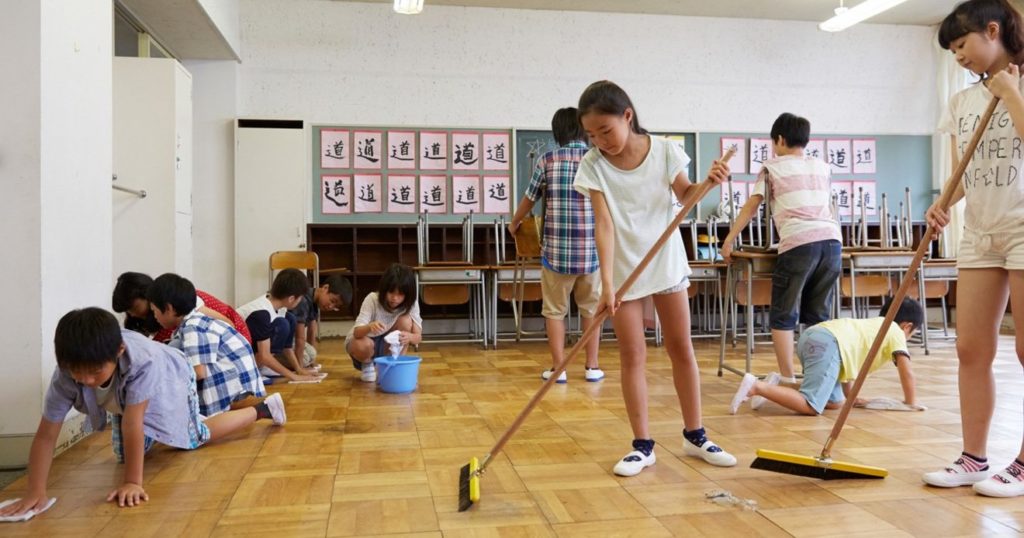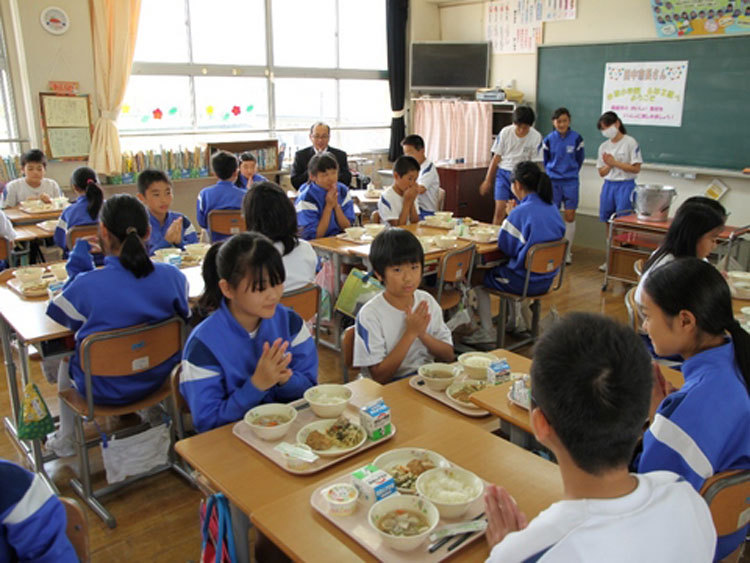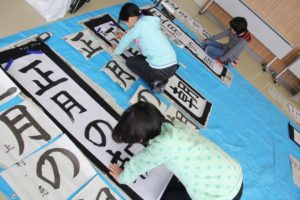“Have you ever been curious about the daily life of a Japanese student?”
In Japan, it is mandatory to go to elementary for 6 years and junior high school for 3 years until children until the age 15 years old. After that, more than 98.8% of children study in high school for 3 years until they reach 18 years old. 58.1% of graduates go to universities and 23.8% of them enter vocational schools.
Although there are similarities between Japanese schools and western schools such as uniforms and grades, there are also several aspects of Japanese schools that may be surprising to many visitors to the country. With its own educational system, Japan has independently molded its youth into the harmonious society it is today.
1. “Randoseru” – Japanese Backpack
2. Children go to school independently without their parent’s help
3. Children clean up school everyday
4. Children serve lunch
5. Lesson – When teachers come to class, children have to bow at the beginning of lessons
6. Most Sports activity is based on school education, not local clubs
7. Taking moral classes is mandatory
8. Taking calligraphy classes is mandatory
9. Evacuation practice every semester
10. Sports Festival – Set Gymnastics, Marching
11. Outdoor Lessons – Pool, Skiing, Long-distance swimming
12. Test of Courage
13. Use respectful language to older people (even 1 year older!)
14. University – Difficult to enter, Easy to graduate
15. Confess one’s feeling before dating
16. Girls present chocolates to boys on Valentine’s day
1. “Randoseru” – Japanese Backpack
In Japanese primary school, 99% of students use a knapsack called “randoseru.” In the past, boys used only black ones and girls used only red ones, and if someone used different colours they tend to be bullied. However, nowadays there are more colour varieties such as pink, blue, purple, brown, green, yellow, etc…
The history of randoseru stems from the fact that bakufu provided knapsacks called ransel, originally from the Netherlands military, towards the end of the Edo era. The emergence of the popularity of the randosel was during Taisyo era when the Japanese prime minister presented this bag to the Taisyo emperor when he started primary school.
✏️ Writer’s Experience:
I was given a red Randoseru from my parents before I entered elementary school. My best friend had a dark green Randoseru, which was very rare at that time.
Randoseru

Colourful randoseru

2. Children go to school independently without their parent’s help
In Japan, children go to school by themselves without their parents’ help. Even 6-year-olds go to school independently. In order to get used to it, there is a group school attendance practice program, where older children of one neighbourhood lead younger children of the same area to the school.
This program is very important during emergencies like Earthquakes or Typhoons when children have to go back home immediately. Therefore, a group school attendance program is practised once a month.
✏️ Writer’s Experience:
In the England FA football coaching license training trial, I was surprised that a coach told the kids “You can leave if you see your parents.” I couldn’t understand why English coaches always said this at the end of football training since it was normal that children go home without their parents in Japan.
Group Walking

In Japanese schools, there is a 30 minute cleaning time every day. All students must clean parts of the school including their own classroom, steps, library, art room, music room, gym, etc…
Once students finish cleaning, a leader calls the teacher who then inspects how clean the school is. If the teacher accepts it, students can finish up, but if not, they have to clean up again until the teacher allows it to finish.
Most Japanese tend to pick up trash when they find it since the Japanese grew up knowing not to leave a mess.
✏️ Writer’s Experience:
The hardest area to clean was the classroom since I needed to move about 40 desks and chairs to clean up the entire classroom…
Cleaning classroom

4. Children serve lunch
During lunchtime, children distribute food themselves. When everybody’s dish is served properly, a student leader calls his/her classmates and says “Please put your hands together, Itadakimasu (Thanks for eating)”.
All children say “Itadakimasu” before they eat. This is a Japanese manner to show appreciation to food and the food maker. After lunchtime finishes, there is a time to brush their teeth.
✏️ Writer’s Experience:
The students serving food have to wear white kits. After Friday, they bring these kits home and wash them before passing them on to the other students.
School Lunch

Itadakimasu

5. Lesson – When teachers come to class, children have to bow at the beginning of lessons
Unlike western schools, in a Japanese school, there’s a home classroom for every child, and teachers of each subject visit the homeroom instead of students visiting separate classes per subject.
Once a teacher enters a classroom, the student leader calls “Stand up!” “Strain yourself!” “Bow!” and all students must bow to their teacher before the lesson starts.
✏️ Writer’s Experience:
When I was in high school, I couldn’t stand up even though the leader was calling because I had sleep paralysis…my teacher got angry. Well, I fell asleep all the time in the lesson before this one…guess it wasn’t too interesting.
Bowing

Sports and physical education in Japan are considered essential. Sports in Japan contain more educational components rather than “play”. Some students practice for more than 2 hours every day, 6 days a week. This differs from schools in western countries, sometimes guts and enthusiasm are prioritised more than a scientific approach.
The most popular sports are Baseball and Football. All high school tournaments are broadcasted. Many high school students dream of playing in these tournaments.
✏️ Writer’s Experience:
I belonged to a football club in my school. The hardest training was running upstairs for 35 minutes! In London, I could enjoy football since there was no such ridiculous training…;)
All high school baseball tournament

7. Taking moral classes is mandatory
Moral class is mandatory for students between 6 to 15-year-old in primary and secondary schools. In Japanese schools, students learn what kind of behaviour would make people happy, what kind of behaviour is the right thing to do as a person.
✏️ Writer’s Experience:
The content that the writer still remembers:
- Someone took another person’s umbrella from the umbrella stock in the store since it started to rain. How does the owner of this umbrella feel?
- In the Edo era, Japanese people helped Turkish sailors lost in the ocean close to Japan. This event is well known in Turkey. In the 21st century, the Japanese government had delayed sending the national flight to rescue Japanese nationals during the Iraq war. Instead, the Turkish government sent a flight to rescue the Japanese nationals. At school, we learn kindness is important and sometimes it will come back to us in the future.
Moral Class

8. Taking calligraphy classes is mandatory
In Japanese schools, calligraphy is mandatory to take in primary and secondary schools. Students learn the traditional way of writing with a traditional pen, ink, and paper. At the beginning of the new year, there is a calligraphy contest called “Kakizome.” Children practice calligraphy during winter vacation.
✏️ Writer’s Experience:
My grandfather is in the highest position in calligraphy. When I asked him to show me how to write good calligraphy for “Kakizome”, he instructed me strictly in order to help me win a prize in this contest. Also, he added and corrected some points of my calligraphy secretly… Of course, I won the prize 😛
Caligraphy

Caligraphy

Japan has a number of earthquakes, and 25% of earthquakes in the world are happening in Japan. Therefore, evacuation practice is inevitable in Japanese schools. Most schools have this practice at least once a semester.
Children always keep their disaster prevention hood on the back of their chair, once the disaster happens, children wear this hood and go under their desk, and evacuate outside as a unit.
✏️ Writer’s Experience:
I realised that this evacuation practice might have an influence on the Japanese project management style. When Japanese people manage projects, they tend to consider and prepare all risks in detail in advance. Whereas, Westerners are more optimistic to plan projects, and make decisions quickly and fix issues when they happen.
Evacuation Practice

Evacuation Practice

10. Sports Festival – Set Gymnastics, Marching
Sports festivals in Japan are very unique. At the beginning of the festival, all students march around the school field. This reminds me of the fact that Japanese physical education had been developed from military training in previous world wars.
The most popular event is “Group Gymnastics.” In Japanese schools, the students of the final grade of primary school unite each other and practice these gymnastics for about a half year. These experiences make Japanese people prioritise groups over individualism.
✏️ Writer’s Experience:
When I was 12 years old, we made a human tower that was 5 stories. It was the highest record at my school!
Human Piramid

11. Outdoor Lessons – Pool, Skiing, Long-distance swimming
Most Japanese schools have a pool, and there are swimming lessons in the summer (depending on the area). Some schools by the seaside have distance swimming training in the ocean. On the other hand, some North area has skiing lessons in winter instead of swimming in summer.
✏️ Writer’s Experience:
In my elementary school, some ducks swim in our pool in spring…
Swimming Class

Test of courage is the horror tour of school trips. Students walk around at night and teachers try to pretend to ghost and surprise the students. Recently, these tests of courage are not conducted anymore due to security reasons.
✏️ Writer’s Experience:
Students needed to make a group with 2 girls and 2 boys. I was asked by my female friend to invite a boy she liked. I invited him successfully, however, she shouted that she could see a ghost while we were walking. He felt worried because he couldn’t see it and the romance didn’t go well…

13. Use respectful language to older people (even 1 year older!)
In Japanese schools, students have to show their respect to older people such as teachers and seniors.
Students need to use respectful language to even seniors who are just 1 year older than them.
For example,
Good morning Ms Sato.
(English: Hey! How’s it going?)
Could you kindly tell me how I should have played in the last football match, please?
(English: Let me know how I should have played in the match!)
✏️ Writer’s Experience:
Hierarchical relationships are very strict in Japan and if I were to speak casually with older people, I would be seen as a rude person. Always show your respect, even if you don’t respect them in your mind!

14. University – Difficult to enter, Easy to graduate
Japanese high school students study so hard in order to pass the university entrance exams. It is said that “Japanese universities are difficult to enter but easy to graduate.”
Most students go to prep school after regular school to get a high score in the exam.
✏️ Writer’s Experience:
I studied for more than 10 hours every day when I was 17 years old. Definitely, don’t want to go back to those days!

Japanese people tend to ask to be in a relationship before they start dating. If boys don’t ask it, girls might feel that she is being played by him…
✏️ Writer’s Experience:
In western countries, people tend to start dating before being in a relationship. In my early days in London, I thought that most western men seemed like playboys since they didn’t ask for it properly… One of my biggest cultural misunderstandings…

16. Girls present chocolates to boys on Valentine’s day
Valentine’s day is one of the most important days for Japanese girls! It’s a good day to confess a girls’ thoughts to boys they like. Girls make chocolates for these boys and present them. It seems this day is the hardest day for those boys who only get chocolates from their mother…
✏️ Writer’s Experience:
I made chocolates with my friends for boys we liked when I was 10 years old. But I thought to save some chocolate for only myself. So when I packed these chocolates, I also added a cup filled with chocolate sauce, for only me!
On White Day, I was expecting that I would get some return from the boy I gave some chocolate to. However, he was absent from school that day. 18 years later, I now understand the reason why he didn’t come to school…his chocolate sauce must have been spilt out in his lunchbox and got messed up by the time he opened his box…:P






































